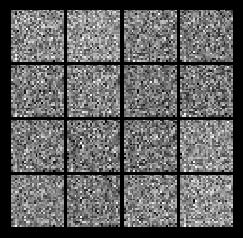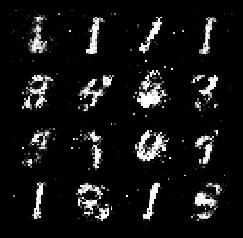Pytorch Note47 Imporving GAN
Posted 风信子的猫Redamancy
tags:
篇首语:本文由小常识网(cha138.com)小编为大家整理,主要介绍了Pytorch Note47 Imporving GAN相关的知识,希望对你有一定的参考价值。
Pytorch Note47 Imporving GAN
全部笔记的汇总贴: Pytorch Note 快乐星球
在这一部分,我们介绍一些改善的生成对抗网络,因为简单的生成对抗网络存在一些问题,所以我们研究是否可以改善网络结构或者损失函数来解决这些问题。
Least Squares GAN
Least Squares GAN 比最原始的 GANs 的 loss 更加稳定,通过名字我们也能够看出这种 GAN 是通过最小平方误差来进行估计,而不是通过二分类的损失函数,下面我们看看 loss 的计算公式
ℓ
G
=
1
2
E
z
∼
p
(
z
)
[
(
D
(
G
(
z
)
)
−
1
)
2
]
\\ell_G = \\frac{1}{2}\\mathbb{E}_{z \\sim p(z)}\\left[\\left(D(G(z))-1\\right)^2\\right]
ℓG=21Ez∼p(z)[(D(G(z))−1)2]
ℓ D = 1 2 E x ∼ p data [ ( D ( x ) − 1 ) 2 ] + 1 2 E z ∼ p ( z ) [ ( D ( G ( z ) ) ) 2 ] \\ell_D = \\frac{1}{2}\\mathbb{E}_{x \\sim p_\\text{data}}\\left[\\left(D(x)-1\\right)^2\\right] + \\frac{1}{2}\\mathbb{E}_{z \\sim p(z)}\\left[ \\left(D(G(z))\\right)^2\\right] ℓD=21Ex∼pdata[(D(x)−1)2]+21Ez∼p(z)[(D(G(z)))2]
可以看到 Least Squares GAN 通过最小二乘代替了二分类的 loss,下面我们定义一下 loss 函数
def ls_discriminator_loss(scores_real, scores_fake):
loss = 0.5 * ((scores_real - 1) ** 2).mean() + 0.5 * (scores_fake ** 2).mean()
return loss
def ls_generator_loss(scores_fake):
loss = 0.5 * ((scores_fake - 1) ** 2).mean()
return loss
D = discriminator().cuda()
G = generator().cuda()
D_optim = get_optimizer(D)
G_optim = get_optimizer(G)
train_a_gan(D, G, D_optim, G_optim, ls_discriminator_loss, ls_generator_loss)
Iter: 0, D: 0.5524, G:0.4728
Iter: 250, D: 0.2155, G:0.1959
…Iter: 3500, D: 0.1186, G:0.3989
Iter: 3750, D: 0.1621, G:0.228
Deep Convolutional GANs
深度卷积生成对抗网络特别简单,就是将生成网络和对抗网络都改成了卷积网络的形式,下面我们来实现一下
卷积判别网络
卷积判别网络就是一个一般的卷积网络,结构如下
- 32 Filters, 5x5, Stride 1, Leaky ReLU(alpha=0.01)
- Max Pool 2x2, Stride 2
- 64 Filters, 5x5, Stride 1, Leaky ReLU(alpha=0.01)
- Max Pool 2x2, Stride 2
- Fully Connected size 4 x 4 x 64, Leaky ReLU(alpha=0.01)
- Fully Connected size 1
class build_dc_classifier(nn.Module):
def __init__(self):
super(build_dc_classifier, self).__init__()
self.conv = nn.Sequential(
nn.Conv2d(1, 32, 5, 1),
nn.LeakyReLU(0.01),
nn.MaxPool2d(2, 2),
nn.Conv2d(32, 64, 5, 1),
nn.LeakyReLU(0.01),
nn.MaxPool2d(2, 2)
)
self.fc = nn.Sequential(
nn.Linear(1024, 1024),
nn.LeakyReLU(0.01),
nn.Linear(1024, 1)
)
def forward(self, x):
x = self.conv(x)
x = x.view(x.shape[0], -1)
x = self.fc(x)
return x
卷积生成网络
卷积生成网络需要将一个低维的噪声向量变成一个图片数据,结构如下
- Fully connected of size 1024, ReLU
- BatchNorm
- Fully connected of size 7 x 7 x 128, ReLU
- BatchNorm
- Reshape into Image Tensor
- 64 conv2d^T filters of 4x4, stride 2, padding 1, ReLU
- BatchNorm
- 1 conv2d^T filter of 4x4, stride 2, padding 1, TanH
class build_dc_generator(nn.Module):
def __init__(self, noise_dim=NOISE_DIM):
super(build_dc_generator, self).__init__()
self.fc = nn.Sequential(
nn.Linear(noise_dim, 1024),
nn.ReLU(True),
nn.BatchNorm1d(1024),
nn.Linear(1024, 7 * 7 * 128),
nn.ReLU(True),
nn.BatchNorm1d(7 * 7 * 128)
)
self.conv = nn.Sequential(
nn.ConvTranspose2d(128, 64, 4, 2, padding=1),
nn.ReLU(True),
nn.BatchNorm2d(64),
nn.ConvTranspose2d(64, 1, 4, 2, padding=1),
nn.Tanh()
)
def forward(self, x):
x = self.fc(x)
x = x.view(x.shape[0], 128, 7, 7) # reshape 通道是 128,大小是 7x7
x = self.conv(x)
return x
def train_dc_gan(D_net, G_net, D_optimizer, G_optimizer, discriminator_loss, generator_loss, show_every=250,
noise_size=96, num_epochs=10):
iter_count = 0
for epoch in range(num_epochs):
for x, _ in train_data:
bs = x.shape[0]
# 判别网络
real_data = x.cuda() # 真实数据
logits_real = D_net(real_data) # 判别网络得分
sample_noise = (torch.rand(bs, noise_size) - 0.5) / 0.5 # -1 ~ 1 的均匀分布
g_fake_seed = sample_noise.cuda()
fake_images = G_net(g_fake_seed) # 生成的假的数据
logits_fake = D_net(fake_images) # 判别网络得分
d_total_error = discriminator_loss(logits_real, logits_fake) # 判别器的 loss
D_optimizer.zero_grad()
d_total_error.backward()
D_optimizer.step() # 优化判别网络
# 生成网络
g_fake_seed = sample_noise.cuda()
fake_images = G_net(g_fake_seed) # 生成的假的数据
gen_logits_fake = D_net(fake_images)
g_error = generator_loss(gen_logits_fake) # 生成网络的 loss
G_optimizer.zero_grad()
g_error.backward()
G_optimizer.step() # 优化生成网络
if (iter_count % show_every == 0):
print('Iter: {}, D: {:.4}, G:{:.4}'.format(iter_count, d_total_error.data, g_error.data))
imgs_numpy = deprocess_img(fake_images.data.cpu().numpy())
show_images(imgs_numpy[0:16])
plt.show()
print()
iter_count += 1
D_DC = build_dc_classifier().cuda()
G_DC = build_dc_generator().cuda()
D_DC_optim = get_optimizer(D_DC)
G_DC_optim = get_optimizer(G_DC)
train_dc_gan(D_DC, G_DC, D_DC_optim, G_DC_optim, discriminator_loss, generator_loss, num_epochs=5)
Iter: 0, D: 1.387, G:0.6381
Iter: 250, D: 0.7821, G:1.807
…
Iter: 1500, D: 1.216, G:0.7218
Iter: 1750, D: 1.143, G:1.092
可以看到,通过 DCGANs 能够得到更加清楚的结果,而且也可以更快地收敛
以上是关于Pytorch Note47 Imporving GAN的主要内容,如果未能解决你的问题,请参考以下文章







